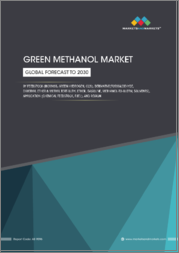
|
시장보고서
상품코드
1488253
감귤계 용제 시장 : 유형별, 용도별, 판매 채널별, 예측(2024-2032년)Citrus Solvents Market - By Type (Organic, Conventional), By Application (Insecticides, Industrial & Domestic Cleaners, Paints & Coatings, Skin & Hair Care, Printing Ink), By Sales Channel & Forecast, 2024 - 2032 |
||||||
감귤계 용제 시장 규모는 친환경적이고 지속가능한 세정액에 대한 수요 증가로 인해 2024년부터 2032년까지 연평균 5.5% 이상의 성장률을 기록할 것으로 예상됩니다.
예를 들어, 2021년 6월 Meter Engineers는 Petro Gone(TM)이라는 신제품을 발표했습니다.
감귤계 용제는 오렌지, 레몬, 자몽과 같은 천연 자원에서 추출되며, 생분해성 및 무해한 특성으로 인해 환경 친화적인 소비자와 산업계에 더욱 매력적으로 다가갈 수 있습니다. 감귤계 용제는 오일과 접착제를 녹이는 능력 등 다양한 용도를 가지고 있어 페인트, 코팅, 세정제, 탈지제, 향료 제조 등 다양한 용도에 적합합니다.
또한, 추출 및 정제 기술의 발전으로 제조업체는 다양한 최종 용도의 까다로운 요구 사항을 충족시키면서 순도, 성능 및 일관성을 향상시킨 고품질 감귤계 용제를 생산할 수 있게 되었습니다. 또한, 천연 성분을 함유한 제품에 대한 선호도가 높아지면서 친환경 용제에 대한 수요가 증가하고 있습니다. 친환경 용제 사용을 장려하고 화학 제조 공정이 환경에 미치는 영향을 줄이기 위한 정부 및 규제 기관의 이니셔티브가 증가함에 따라 시장 확대의 기회를 창출할 것으로 보입니다.
감귤계 용제 산업은 유형, 용도, 판매 채널, 지역별로 구분됩니다.
유형별로 보면 전통적인 부문의 시장 규모는 2032년까지 연평균 5.3%의 CAGR을 기록할 것으로 예상됩니다. 이는 기존 시장에서의 확고한 입지, 입증된 성능 및 비용 효율성 때문인 것으로 분석됩니다. 많은 산업, 특히 공급망과 제조 공정이 확립된 산업은 세척, 탈지 및 용제 수요를 전통적인 감귤계 용제에 의존하고 있습니다. 또한, 용도에 따라 특정 용제의 특성이 뚜렷한 특정 용제가 필요한데, 기존 감귤계 용제는 안정적인 품질과 쉽게 구할 수 있는 공급망으로 이러한 요구 사항을 효과적으로 충족하고 있습니다.
감귤계 용제의 시장 규모는 화장품 및 퍼스널케어 제품에서의 사용 증가로 인해 피부 및 모발 응용 분야에서 2024-2032년 5.9%의 CAGR을 기록할 것으로 예상됩니다. 감귤계 용제는 천연 유래의 피부 친화적인 성분으로 모발과 피부 표면의 유분, 얼룩, 잔여물을 제거하는 효과가 있어 인기를 끌고 있습니다. 이러한 용제는 자극이나 건조함 없이 불순물을 용해시키는 능력이 있기 때문에 클렌징, 로션, 메이크업 리무버 등 다양한 스킨케어 제품의 제형에 적용되고 있습니다.
아시아태평양의 감귤계 용제 산업은 2032년까지 5.7%의 성장률을 보일 것으로 예상되며, 특히 중국, 인도, 일본 등 감귤류 생산량이 풍부한 국가들에서 성장세가 두드러질 것으로 전망됩니다. 세정, 페인트 및 코팅, 퍼스널케어 등 모든 산업의 제조 공정에서 친환경적이고 지속가능한 관행이 채택되면서 석유 기반 용제를 대체할 천연 용제로 감귤계 용제에 대한 수요가 증가하고 있습니다. 신흥국의 급속한 산업화와 도시화로 인해 효과적인 세정 솔루션에 대한 수요가 증가함에 따라 이 지역의 시장 확대가 더욱 가속화되고 있습니다.
목차
제1장 조사 방법과 조사 범위
제2장 주요 요약
제3장 업계 인사이트
- 생태계 분석
- 주요 제조업체
- 유통업체
- 업계 전체의 이익률
- 공급 혼란
- 업계에 대한 영향요인
- 성장 촉진요인
- 시장 과제
- 시장 기회
- 새로운 기회
- 성장 가능성 분석
- 원재료 상황
- 제조 동향
- 기술의 진화
- 지속가능한 제조
- 그린 프랙티스
- 탈탄소화
- 지속가능한 제조
- 원재료의 지속가능성
- 원재료 가격 동향(달러/톤)
- 미국
- 유럽연합
- 영국
- 중국
- 동남아시아
- GCC
- 규제와 시장에 대한 영향
- 무역 통계
- 미충족 수요
- Porters 분석
- PESTEL 분석
제4장 경쟁 상황
- 기업 점유율 분석
- 경쟁 포지셔닝 매트릭스
- 전략 전망 매트릭스
제5장 시장 규모와 예측 : 유형별, 2018-2032년
- 주요 동향
- 유기농
- 기존
제6장 시장 규모와 예측 : 용도별, 2018-2032년
- 주요 동향
- 살충제
- 산업용·가정용 클리너
- 페인트 및 코팅
- 스킨케어·헤어케어
- 인쇄용 잉크
- 기타
제7장 시장 규모와 예측 : 판매 채널별, 2018-2032년
- 주요 동향
- 직접 판매
- MT
- 전문점
- 모노 브랜드 매장
- 온라인 숍
- 기타
제8장 시장 규모와 예측 : 지역별, 2018-2032년
- 주요 동향
- 북미
- 미국
- 캐나다
- 유럽
- 독일
- 영국
- 프랑스
- 이탈리아
- 스페인
- 기타 유럽
- 아시아태평양
- 중국
- 인도
- 일본
- 한국
- 호주
- 기타 아시아태평양
- 라틴아메리카
- 브라질
- 멕시코
- 아르헨티나
- 기타 라틴아메리카
- 중동 및 아프리카
- 사우디아라비아
- UAE
- 남아프리카공화국
- 기타 중동 및 아프리카
제9장 기업 개요
- Archer Daniels Midland Company
- Burdock & Associates, Ltd.
- Citrosuco S.A.
- Citrus Oleo
- D-Limonene Company
- EcoLogic Solutions
- Esters and Solvents LLP
- Florachem
- Industrial Solvents & Chemicals Private Limited
- Lemon Concentrate S.L.
- Louis Dreyfus Company B.V.
- Mentha & Allied Products Ltd.
- Norkem Group
- Peace River Citrus Products
- Sucocitrico Cutrale Ltd.
- Zep Inc.
Citrus Solvents Market size is estimated to register over 5.5% CAGR from 2024 to 2032, driven by the increasing demand for eco-friendly and sustainable cleaning solutions. For instance, in June 2021,
Meter Engineers released a new product named Petro Gone(TM), an eco-friendly citrus-based solvent that removes hydrocarbons before meter prover calibration.
Citrus solvents are derived from natural sources, such as oranges, lemons, and grapefruits, making them biodegradable and non-toxic, further appealing to environmentally conscious consumers and industries. The versatile properties of citrus solvents, including their ability to dissolve oils, greases, and adhesives, has also surged their suitability for a wide range of applications across paints & coatings, cleaners and degreasers, and fragrance manufacturing.
Moreover, the growing advancements in extraction and purification technologies are enabling manufacturers to produce high-quality citrus solvents with enhanced purity, performance, and consistency while meeting the stringent requirements of various end-use applications. There is also an increasing preference for products formulated with natural ingredients and the growing demand for green solvents. Rising initiatives by governments and regulatory bodies to promote the use of eco-friendly solvents and reduce the environmental impacts of chemical manufacturing processes will create opportunities for the market expansion.
The citrus solvents industry is segmented based on type, application, sales channel and region.
By type, the market size from the conventional segment is anticipated to witness 5.3% CAGR through 2032, due to their established presence, proven performance, and cost-effectiveness. Many industries, especially those with established supply chains and manufacturing processes, rely on conventional citrus solvents for their cleaning, degreasing, and solvent needs. Additionally, some applications require specific solvents with well-defined properties, and conventional citrus solvents, with their consistent quality and readily available supply to continue to meet these requirements effectively.
Citrus solvents market value from the skin & hair application segment will record 5.9% CAGR during 2024-2032, owing to its increasing utilization in cosmetic and personal care products. Citrus solvents are gaining popularity due to their natural origin, mildness on the skin, and effectiveness in removing oils, dirt, and residues from hair and skin surfaces. These solvents are also incorporated into formulations of various skincare products, such as cleansers, toners, and makeup removers due to their ability to dissolve impurities without causing irritation or dryness.
Asia Pacific citrus solvents industry is slated to depict 5.7% growth rate through 2032, favored by the abundant citrus fruit production, particularly in countries like China, India, and Japan. The increasing adoption of eco-friendly and sustainable practices in manufacturing processes across industries, including cleaning, paints & coatings, and personal care is fueling the demand for citrus solvents as natural alternatives to petroleum-based solvents. The rapid industrialization and urbanization in emerging economies resulting in the growing need for effective cleaning solutions is further stimulating the regional market expansion.
Table of Contents
Chapter 1 Methodology & Scope
- 1.1 Market scope & definition
- 1.2 Base estimates & calculations
- 1.3 Forecast calculation
- 1.4 Data sources
- 1.4.1 Primary
- 1.4.2 Secondary
- 1.4.2.1 Paid sources
- 1.4.2.2 Public sources
Chapter 2 Executive Summary
- 2.1 Industry 360 degree synopsis
Chapter 3 Industry Insights
- 3.1 Industry ecosystem analysis
- 3.1.1 Key manufacturers
- 3.1.2 Distributors
- 3.1.3 Profit margins across the industry
- 3.1.4 Supply disruptions
- 3.2 Industry impact forces
- 3.2.1 Growth drivers
- 3.2.2 Market challenges
- 3.2.3 Market opportunity
- 3.2.3.1 New opportunities
- 3.2.3.2 Growth potential analysis
- 3.3 Raw material landscape
- 3.3.1 Manufacturing trends
- 3.3.2 Technology evolution
- 3.3.2.1 Sustainable manufacturing
- 3.3.2.1.1 Green practices
- 3.3.2.1.2 Decarbonization
- 3.3.2.1 Sustainable manufacturing
- 3.3.3 Sustainability in raw materials
- 3.3.4 Raw material pricing trends (USD/Ton)
- 3.3.4.1 U.S.
- 3.3.4.2 European Union
- 3.3.4.3 UK
- 3.3.4.4 China
- 3.3.4.5 Southeast Asia
- 3.3.4.6 GCC
- 3.4 Regulations & market impact
- 3.5 Trade statistics
- 3.6 Unmet needs
- 3.7 Porter's analysis
- 3.8 PESTEL analysis
Chapter 4 Competitive Landscape, 2023
- 4.1 Company market share analysis
- 4.2 Competitive positioning matrix
- 4.3 Strategic outlook matrix
Chapter 5 Market Size and Forecast, By Type, 2018-2032 (USD Billion, Kilo Tons)
- 5.1 Key trends
- 5.2 Organic
- 5.3 Conventional
Chapter 6 Market Size and Forecast, By Application, 2018-2032 (USD Billion, Kilo Tons)
- 6.1 Key trends
- 6.2 Insecticides
- 6.3 Industrial & domestic cleaners
- 6.4 Paints & coatings
- 6.5 Skin & hair care
- 6.6 Printing ink
- 6.7 Others
Chapter 7 Market Size and Forecast, By Sales Channel, 2018-2032 (USD Billion, Kilo Tons)
- 7.1 Key trends
- 7.2 Direct sales
- 7.3 Modern trade
- 7.4 Specialty store
- 7.5 Mono brand store
- 7.6 Online retailers
- 7.7 Other
Chapter 8 Market Size and Forecast, By Region, 2018-2032 (USD Billion, Kilo Tons)
- 8.1 Key trends
- 8.2 North America
- 8.2.1 U.S.
- 8.2.2 Canada
- 8.3 Europe
- 8.3.1 Germany
- 8.3.2 UK
- 8.3.3 France
- 8.3.4 Italy
- 8.3.5 Spain
- 8.3.6 Rest of Europe
- 8.4 Asia Pacific
- 8.4.1 China
- 8.4.2 India
- 8.4.3 Japan
- 8.4.4 South Korea
- 8.4.5 Australia
- 8.4.6 Rest of Asia Pacific
- 8.5 Latin America
- 8.5.1 Brazil
- 8.5.2 Mexico
- 8.5.3 Argentina
- 8.5.4 Rest of Latin America
- 8.6 MEA
- 8.6.1 Saudi Arabia
- 8.6.2 UAE
- 8.6.3 South Africa
- 8.6.4 Rest of MEA
Chapter 9 Company Profiles
- 9.1 Archer Daniels Midland Company
- 9.2 Burdock & Associates, Ltd.
- 9.3 Citrosuco S.A.
- 9.4 Citrus Oleo
- 9.5 D-Limonene Company
- 9.6 EcoLogic Solutions
- 9.7 Esters and Solvents LLP
- 9.8 Florachem
- 9.9 Industrial Solvents & Chemicals Private Limited
- 9.10 Lemon Concentrate S.L.
- 9.11 Louis Dreyfus Company B.V.
- 9.12 Mentha & Allied Products Ltd.
- 9.13 Norkem Group
- 9.14 Peace River Citrus Products
- 9.15 Sucocitrico Cutrale Ltd.
- 9.16 Zep Inc.



















